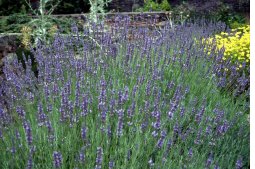 |
 |
Lavender
The most popular plant in any herb garden, There is nothing more nostalgic than the smell of lavender wafting through the garden on a warm summer’s day.
< Lavandula ‘Munstead’ Click here to buy online
The Romans first introduced lavender to the UK who used it in their bathwater for its scent, to promote the healing of cuts and wounds, and as a flea and nit repellant. Since the 17th century, the French have grown huge fields of lavender for the perfume industry.
Native of the Mediterranean region, Canary Islands and India, lavender is naturally a drought-loving plant and like most Mediterranean plants copes well in long hot summers when rain is scarce.
There are hundreds of different varieties of lavender to choose from – from tall to dwarf, from blues and purples to pale pinks and greens – something to suit every garden.
Varieties
There are three main types of lavender: hardy, tender and bract lavenders.
Hardy lavenders include Lavendula x intermedia or Old English Lavender, the quintessential herb that smells good, looks good and does you good. This variety, with its clear, pale blue-purple flowers and long narrow silver-grey-green leaves, is a hybrid bred to produce a high yield of essential oil.
look out for the tender lavenders, such as Lavandula canariensis, Lavandula candicans, Lavandula pinnata, Lavandula dentata and Lavandula viridis (a green flowering lavender). They all have a longer flowering season with a scent and flavour more like eucalyptus. They make excellent summer bedding plants and are wonderful when grown in containers.
Bract lavenders feature the most amazing colour bracts or little ‘ears’ as they are commonly called, which look like small colourful bees or even butterflies. Lavandula stoechas or French Lavender has deep purple flowers topped with short mauve-purple bracts from late spring until early autumn. Lavendula stoechas ‘Kew Red’ has unique cerice-crimson flowers with pale pink bracts. This variety needs to be protected from wet winters.
Cultivation
Grow hardy and bract lavenders in a sunny position, in fertile free-draining soil. It is wet conditions and high humidity that kill these plants, not the cold.
Trim lavenders each year, either after flowering in the early autumn or in spring in cold, wet climates. Do not cut into the old wood, as it will not produce new growth.
Bract and tender lavenders have a long flowering period from late spring until early autumn. Regular deadheading encourages new young growth and the plant will bush out while not becoming too woody.
In the UK and other cold climates, you should bring in tender lavenders before the first frosts, ideally into a heated glasshouse or conservatory.
Uses
There are so many uses for lavender flowers. A tea made from lavender flowers can help you sleep. Put them into little bags in your wardrobe to repel moths or add a few drops of lavender oil to hot bath water to help you relax after a hard day’s work – heavenly! Rubbed into the temples, the oil can also help ease headaches.
Not so many people use lavender as a culinary ingredient these days, but the aromatic flavour of lavender combines well with pudding, biscuits and cakes. It works particularly well with roast lamb and chicken – next time you have a barbecue, try using a little lavender oil to baste chicken pieces.
Recipe of the Month – Lavender Biscuits
Ingredients
100g / 4oz butter 50g / 2oz caster sugar 175g / 6oz self-raising flour 2 tablespoons fresh chopped lavender leaves 1 teaspoon lavender flowers removed from spike
Method
Cream the sugar and butter together until light. Add the flour and lavender leaves to the butter mixture. Knead well until it forms a dough. Gently roll out on a lightly floured board. Scatter the flowers over the rolled dough and lightly press in with the rolling pin. Cut into small rounds with cutter. Place biscuits on a greased baking sheet. Bake in a hot over 450°F / 230°C, gas mark 7 for 10-12 minutes until golden and firm. Remove at once and cool on a wire tray.
|
